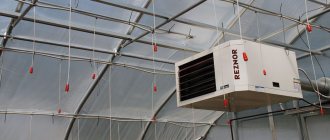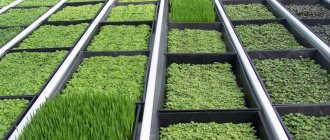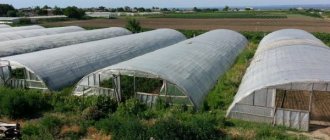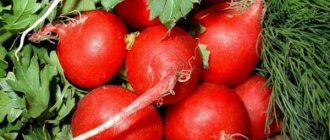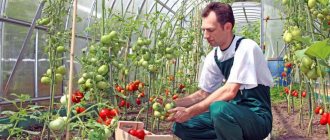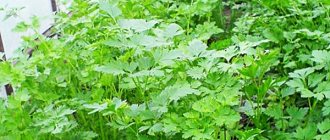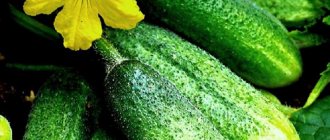Agricultural products are always in great demand, and fresh cucumbers are no exception. When choosing fresh or canned tomatoes or cucumbers in a supermarket or market, the consumer focuses not only on their appearance, but also on the manufacturer, giving preference to domestic products. Therefore, a business growing cucumbers in a greenhouse will provide you with a stable income all year round.
Why greenhouse cucumbers
The idea of growing cucumbers in greenhouses cannot be called new, and, at first glance, it can be said that it has no prospects. But it is precisely the fact that the domestic market for agricultural products is experiencing difficult times that provides favorable conditions for small and beginning entrepreneurs to conduct this type of activity.
- Firstly, the largest greenhouse farms are forced to suspend their activities due to a lack of funds necessary to modernize old greenhouse complexes.
- Secondly, fresh and organic cucumbers will always be in demand, unlike imported ones.
- Thirdly, anyone can organize a small, profitable greenhouse business. To do this, you do not need to be the owner of large plots of land. In any rural settlement, you can inexpensively rent a small plot of land for the construction of greenhouses.
Cultivation technologies
Regular control over the growth and development of plants allows you to obtain up to three harvests in one year. Considering that in winter and early spring the demand for products is especially high, the price of cucumbers increases significantly.
It is important to know such points as preparing the soil in the greenhouse in the fall, watering regimes and rules, what fertilizers are applied and the rules for their use.
To improve productivity, it is important to follow the cultivation technology of this crop. First of all, the temperature regime is important, since cucumber is a heat-loving plant. Regardless of the time of year, the temperature during the day should remain at 22-26 degrees, and at night – 17-20. The recommended air humidity is up to 85%; as this indicator increases, the risk of developing dangerous diseases, such as powdery mildew, increases. Illumination should be maintained 12 hours a day so that the green parts of the plant always receive the ultraviolet radiation necessary for growth.
Personal subsidiary plot
For beginning entrepreneurs of this type of activity, the best option for choosing an organizational and legal form is a personal subsidiary plot (LPH). Owners of private household plots are completely exempt from paying taxes. A significant advantage is that any products sold that were produced during the management of private household plots are not considered entrepreneurial activity. That is, by selling your cucumbers through a chain of stores, you will not need to collect permits, certificates, etc. You will only need to obtain a certificate from the local government about the origin of the products you are selling and enter into a regular sales contract. To obtain the status of owner of a private household plot, you need to be the owner or rent a plot of land no more than 2 hectares.
Organizational plan
The business is officially registered and professional workers are hired. A case opening schedule is being developed.
Required Personnel
If a small number of cucumbers are grown at the first stages, then the entrepreneur himself can cope with the work, but as the planted area of land increases, it is necessary to hire assistants.
It is advisable to use the services of an accountant, and it is possible to employ him or pay for one-time services.
Business registration
Private household plots are not considered a business, but if you plan to cooperate with large buyers, which include shops or restaurants, you will have to officially register the activity. For this purpose, a simplified regime for agricultural producers is also selected.
Opening schedule
The procedure for opening a cucumber growing business is divided into stages:
- 1 month – registration, search for premises and workers;
- Month 2 – purchase and installation of greenhouses, acquisition and installation of equipment for them;
- Month 3 – purchasing and planting seedlings or seeds.
Thus, approximately 2.5 months after the work is completed, the first harvest can be expected.
Individual entrepreneurship
If you are planning to create a large retail distribution network, then we will be talking about a fairly impressive volume of agricultural products. In this case, the optimal solution would be to register an individual business. As mentioned above, the Russian consumer prefers domestically produced products, and to confirm their origin they need a certificate, declaration of conformity and a sticker on the packaging. Such documents are issued only to legal entities or individual entrepreneurs.
Varieties
When choosing a cucumber variety for industrial cultivation, it is recommended to choose only greenhouse parthenocarpic hybrids that are capable of pollination and forming ovaries without insects. In addition, the following characteristics of varieties should be taken into account:
- Maturing period. It is advisable to choose only early-ripening hybrid varieties with a growing season of up to 45 days.
- Productivity. This factor directly affects the profitability of your garden. For industrial cultivation, varieties with a yield of 7 kg/m2 and a fruit weight of 70 g are suitable.
- Immunity. Thanks to selection, most modern hybrids are resistant to diseases characteristic of the crop. This characteristic is extremely important when growing in cold or humid climates.
- Purpose. Each variety has unique flavor characteristics and suitability for a particular purpose. Some cucumbers are best used in salads, while others are suitable only for preservation. To increase the range of products, it is recommended to grow different hybrids.
Depending on their purpose, cucumbers are divided into the following groups:
- Salad. They have the shortest shelf life, delicate taste and thin skin. Popular varieties: Zozulya, Vivat, Emelya, Kassandra F1.
- Salting. They do not lose their presentation for a long time, but have average taste characteristics and thick skin. Varieties: Altai, Usadebka, Beregovoy, Karelian. Other varieties of pickling cucumbers can be found at this link.
- Universal. Suitable for both long-term storage and fresh consumption. Varieties: April, White Night, German, Masha, Claudia F1.
There are several hundred different varieties and hybrids of this vegetable crop. It is recommended to experiment with seed selection to find the right variety for your conditions.
When choosing a cucumber variety, its regional affiliation plays an important role. Typically, the packaging always indicates the optimal climatic conditions for growing.
How to achieve high yields
Achieving high yields is actually not difficult at all. The whole secret lies in the use of a three-rotation technique for growing cucumbers, where one harvest occurs in the summer, and two harvests in the spring-winter-autumn months. The key point of this business idea lies precisely in the summer harvest. It is during this period that you can do without heating and lighting. Consequently, the cost of production will be much lower. The income received from this harvest will 100% cover future expenses in the autumn-winter period.
Ways to grow cucumbers all year round
In a greenhouse and in open ground, cucumber can be grown in two ways - horizontally or vertically. In the first option, the lashes are laid directly on the beds, and for the second type, special supports are required. Tying up plants saves planting space and also improves the lighting process. Three technologies are used for industrial cultivation of cucumbers:
- Growing in a barrel. Typically a container with a volume of at least 200 liters is used. A substrate made of a mixture of sawdust, black soil, wood ash and peat is laid out there in layers. Up to 4 bushes can be planted in one barrel, which begin to hang down as they develop. This method of growing allows you to save space, since containers can be placed on any free corner of the site.
- On hydroponics. It is considered the most labor- and financially expensive method, but one of the most effective.
- In bags. For this purpose, bags made of dense polyethylene with a capacity of up to 120 liters are used. It is filled 2/3 with soil with the addition of organic matter or synthetic fertilizers. A vertical support for the stem is placed approximately in the central part of the bag, the edges are tucked in to form a side. The grow bag can be placed anywhere in the garden or in the greenhouse.
- On the trellis. This is a lattice or mesh, placed vertically or at an angle, onto which cucumber bushes are tied. The design allows the lashes to be directed upward, which has a beneficial effect on plant health and increases the amount of light. With this growing method, a greenhouse, open ground beds, or containers with substrate are used.
When choosing a growing method, you should consider the access of bees or others to plants for subsequent pollination, if this is provided for by the characteristics of the variety.
The use of trellises is the most common technology for growing cucumbers for sale, since this method increases yield and makes it easier to care for plants.
Establishing product sales channels
The main distribution channels include:
- Grocery stores;
- Vegetable markets;
- Wholesale bases;
- Intermediaries between grocery stores and wholesale centers;
- Direct sales from the place of production.
Each of the listed distribution channels has a number of advantages and disadvantages regarding the final cost, volumes sold, etc. It is recommended to establish a stable sales network in advance in order to avoid losses from overproduction in the future.
Necessary equipment for organizing a business
Of the equipment that will need to be purchased for growing cucumbers, the following should be highlighted:
- material and tools for installation and installation of greenhouses (if you have additional funds, you can purchase kits of greenhouses ready for installation and use the services of their installation);
- plant watering system (also either assembled from component elements or purchased as a kit);
- boilers, pipes and radiators for setting up a heating system for greenhouses;
- lamps and additional equipment for greenhouse lighting systems;
- gardening tools (shovels, hoes, rakes);
- materials for arranging storage areas for auxiliary materials and assembling finished products;
- a car for transporting finished products (not a mandatory item, but having cucumbers delivered to their destination will significantly increase the number of your customers);
- computer and other org. technique.
How much money do you need to invest to create a greenhouse?
Greenhouse farming, like any other business, requires capital investment. The purchase of greenhouses, the necessary equipment, as well as their installation on a plot of land with a total area of at least 500 m² will require approximately one and a half million rubles.
Initial investment:
- Components for the construction of greenhouses – 650,000 rubles;
- Equipment for heating the soil – 120,000 rubles;
- Heating boilers – 70,000 rubles;
- Automatic watering system – 30,000 rubles;
- LED lamps – 550,000 rubles;
- Transport costs – 50,000 rubles;
- Other expenses (seeds, fertilizer, electrical wiring, pipes) – 150,000 rubles.
Total – 1,620,000 rubles.
Annual expenses:
- Fuel – 150,000 rubles;
- Purchase of seeds – 17,000 rubles;
- Payment for electricity – 16,000 rubles;
- Fertilizer – 20,000 rubles.
Total – 203,000 rubles.
Expenses
Like any other type of business, growing cucumbers involves costs for the production of goods, their storage, transportation and sale. In the first stages, investments may exceed income, since a large amount is spent on creating conditions for cultivation. In the future, investments will only be required for consumables, repair and maintenance of greenhouses, and work with finished products.
Necessary equipment
To increase productivity and ease of care, you need to purchase the following devices and tools:
- Greenhouse or greenhouse. Only metal profiles should be used as a frame, since wooden beams will have to be renewed over time. The best materials for covering are polycarbonate, film or glass. Polycarbonate greenhouses are often used for growing. The optimal wall thickness for retaining heat and light should be 8-10 mm. Purchasing a finished greenhouse for a medium-sized plot will cost 250-300 thousand rubles.
- Hand tool. They make the process of working with plants easier. To grow cucumbers, you need garden shears, a large and small shovel, as well as a watering can and plastic buckets. You need to budget at least 3-5 thousand rubles for the instrument.
- Storage boxes. You need to immediately purchase a sufficient amount of containers for transporting and storing the crop, for example, wooden boxes. On average, their cost is 25 rubles, with a total quantity of 20 pieces. they will cost 500 rubles.
- Support materials. These can be wooden rods or metal wire for trellises. If your budget allows, it is recommended to immediately purchase a steel frame to support the branches of the bush. When using wire, 4 thousand rubles are required.
- Other equipment. To measure soil moisture, it is advisable to have a hygrometer in order to timely regulate soil quality, and to measure the temperature inside greenhouses, thermometers (mercury or electronic) are needed. The cost depends on the quality of the devices, the average price is from 500 rubles, the total cost is 2 thousand rubles.
- To start growing, equipment costs are 310-320 thousand rubles. When assembling a greenhouse yourself, you can save a large part of your budget, since materials outside the kit are much cheaper.
Monitoring soil acidity using a pH tester
Greenhouse growing equipment can be purchased gradually as sales revenue increases. This will save part of the budget at the initial stage, since with a small volume of production you can make do with scrap materials.
Growing and care
Growing materials are an important expense that is repeated every planting cycle. To begin with, the business plan should include the following expenses:
- Planting material. For a greenhouse with an area of 100 m2, at least 250 pieces are needed. seeds Their cost depends on the quality of the variety, the average price is 1 thousand rubles per 1000 pieces.
- Container for seedlings. It is advisable to purchase peat cassettes, with which you can avoid picking seedlings. The average price for 8 cells is 12 rubles. You will need at least 30 pieces.
- Fertilizers. Liquid complex fertilizers containing all the necessary elements are suitable. They are economical to use, so only a small amount of the drug is needed. Consumption – 2 thousand rubles per cycle.
- Irrigation system. For small planting volumes, it is recommended to water the plants manually; as production develops, it is necessary to install an automatic watering system. The manual method requires only a water container, a pump and a hose system (15 thousand rubles).
- Priming. It is required both for seedlings and the surface layer in the greenhouse. It is recommended to purchase special soil for growing cucumbers. The total annual cost is 10 thousand rubles.
Consumables for one cycle will cost 25-30 thousand rubles. With established sales, the investment will pay off after selling 200 kg of fresh vegetables.
Greenhouse equipment, plan
To ensure comfortable growth and rapid ripening of cucumbers, it is extremely important to properly equip the greenhouse. An industrial structure must include the following elements:
- a ventilation system is necessary to completely ventilate the greenhouse, which reduces the risk of disease development. In the early stages, you can use vents, but in the future it is recommended to purchase fans or convectors;
- lighting allows you to increase yields and speed up the growing season. Incandescent lamps cannot provide the required amount of ultraviolet light, so it is advisable to purchase LEDs or infrared lamps;
- Heating allows you to regulate the temperature in the greenhouse, maintaining it within acceptable values. Heating can be stove, electric or boiler depending on the budget.
Greenhouse equipment can be purchased gradually as sales income increases. To begin with, you can buy the simplest devices that maintain optimal conditions for plants. You should budget at least 70 thousand rubles for this.
What documents are needed to open
If you are going to farm, then state registration of peasant farms is required, i.e. peasant farming. But this is the case when there is extensive work and large areas of land under agricultural crops (more than 1 hectare). Otherwise, the law allows you to have a personal farm (in your own backyard) and grow agricultural products for sale without taxation. To register a peasant farm, you need: an application for state registration, a passport of the founder of the company, agreements, a decision on the establishment of a peasant farm (if there are several founders). Then, confirmation of payment of the state duty and the actual place of residence of the founder. If the enterprise is founded by one person, an agreement on the establishment of a peasant farm is not needed.
Main risks
Competition is an important factor for small towns, whose residents grow cucumbers on their own in their dachas and garden plots. The demand for fresh vegetables increases only on holidays, and during the summer season the cost of cucumbers is quite low.
The main risk for any business associated with growing vegetables and fruits is plant diseases and the risk of crop loss. Deep knowledge of agronomy, choosing the right site and disease-resistant varieties, purchasing high-quality equipment and fertilizers will help minimize these risks.
Seed selection
Germination, plant development, ability to resist diseases, and productivity depend on the choice of seeds for planting.
The market is saturated with a variety of seeds. The packaging with planting material must contain:
- cellophane window for viewing seeds;
- name of the country of origin;
- name of the packing company;
- name of the culture;
- indication of the hybrid or variety;
- labeling;
- mass;
- harvest year;
- indication of germination period;
- GOST
Gardener's Note : Cucumber seeds can germinate after 8-10 years if stored properly.
Foil or laminated packaging best preserves the properties of planting material. The seeds should be large, full, without stains or traces of mold. There are coated seeds, they are considered the best. These seeds are treated with a fungicide and ensure 100% germination.
Specifics of care
Caring for seedlings is as follows:
- fertilizing with mineral fertilizers;
- fertilizing with organic fertilizers;
- It is important to alternate the application of fertilizers. You should apply one type of fertilizer, and after 10 days another, adhere to this scheme constantly;
- maintaining temperature, humidity, lighting;
- plant garter;
- formation of lashes;
- removal of vines that bear fruit and old leaves.
It is interesting to know that puncturing the soil with a pitchfork around the root system of plants delivers oxygen to the roots, accelerating growth and fruiting
Personnel
To work in greenhouses with a total area of 0.5 hectares, it is worth hiring 3-4 workers. If you do not have an agronomic education, be sure to invite a specialist to work. A scientific approach to selecting seeds, increasing soil fertility and knowledge of the secrets of growing vegetable crops will allow you to avoid mistakes and achieve the highest possible profitability of the farm.
At first, you can hire an experienced part-time accountant to maintain financial records and prepare tax returns. You also need a driver to deliver cucumbers to wholesale buyers.
Salary depends on the average level in your region. Experienced owners advise not to skimp on wages. This will prevent theft and neglect of work.
Marketing
You should start looking for buyers even before the harvest appears. The most effective and promising direction is the environmental friendliness of products. The use of organic fertilizers still increases the cost of vegetable crops, but scientists are actively working to reduce it. In the near future, most farms will switch to working on the principles of organic farming. Anyone who occupies this niche in the forefront is doomed to success.
Having the necessary certificates, you will be able to offer cucumbers to large retail chains, restaurants, school canteens and kindergartens.
Plan to expand your assortment and create your own distribution network. If your brand is associated with quality and a high level of service, high profits are guaranteed.
Sell lightly salted cucumbers, try to organize the production of salads, pickled and pickled vegetables. A wide range and prompt response to changes in demand will allow you to not depend on the season.
What you need to build a greenhouse with your own hands
To save on a finished greenhouse, you can install it yourself, since you will not need to pay for the work of craftsmen, the structure will be cheaper. What you need for construction:
- For the foundation you will need stone and cement;
- Ready-made arched posts or frame material that is made to order;
- Polycarbonate or greenhouse film for covering.
A wear-resistant and durable material is polycarbonate; it is much stronger than film, retains heat and transmits light.
What you will need to purchase inside the structure:
- Equipment for working with earth;
- Ventilation;
- Hoses for watering plants;
- Heating system (for example, boiler);
- Photo lamps for lighting in the cold season (when there is a short sunny day);
- Soil heating system.
2. This is necessary for the construction of a greenhouse; you can see how the structure is built in numerous videos on YouTube.
